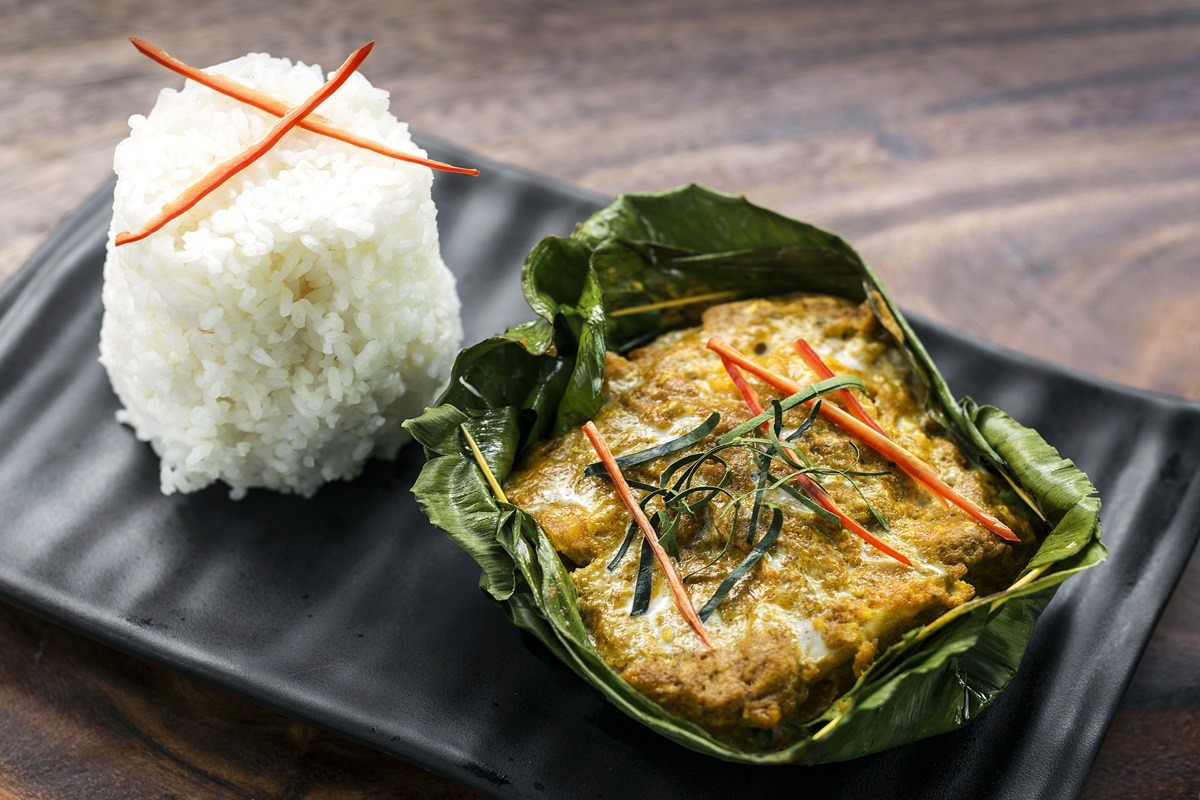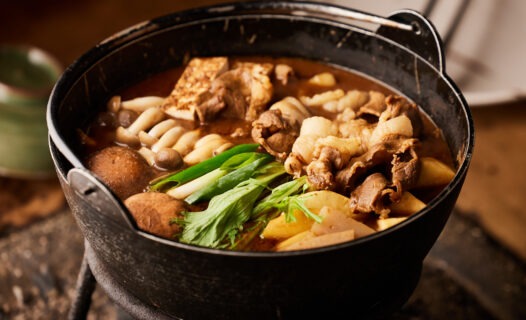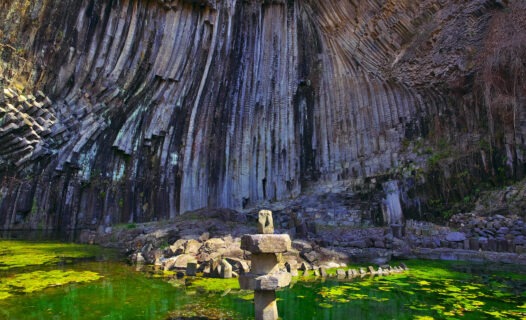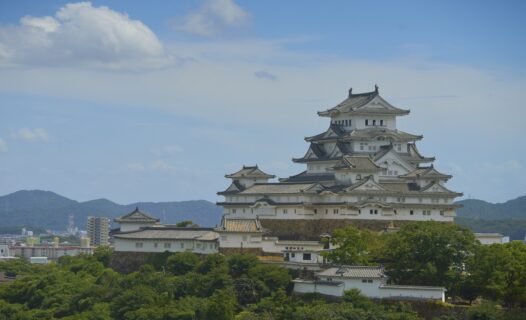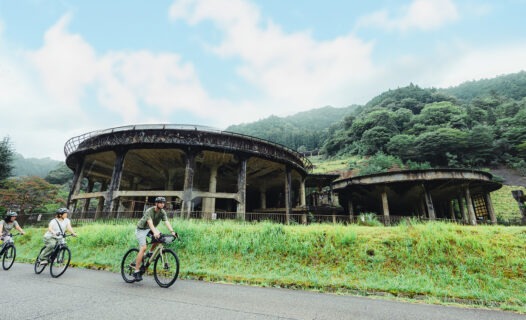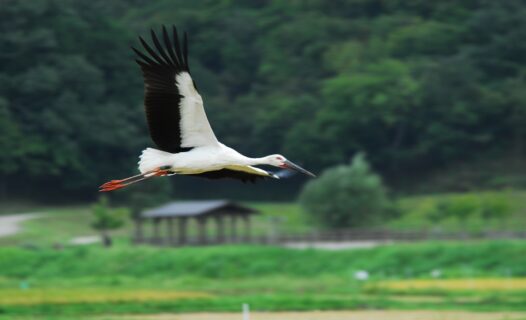Khmer food is a living expression of Cambodia‘s history, geography, and culture, from the fish caught fresh on Tonlé Sap, Southeast Asia’s largest freshwater lake, to Kampot pepper harvested along the country’s southern coast. Plus, whether you’re eating at a family-run eatery in Phnom Penh or cracking crab at a market in Kep, payment with Visa is simple, secure, and widely accepted. So, head out with confidence to explore the country’s signature dishes and standout dining spots while taking advantage of restaurant deals with Visa along the way.
Cambodian Must-Try Dishes
There’s no better way to begin a Khmer food guide than with the dishes that locals eat daily and visitors dream about long after leaving. These must-try dishes are the staples of Khmer cuisine. They have deep traditional roots, come in different varieties according to region, and offer delicious flavors you won’t soon forget.
Fish Amok
Fish amok is arguably the crown jewel of traditional Khmer dishes. It’s a delicate curry made from white fish, usually catfish or snakehead, with a smooth blend of coconut milk, lemongrass, turmeric, galangal, and the all-important kroeung paste, all steamed in a banana leaf. The banana leaf not only infuses the dish with a subtle herbal fragrance but also gives it a beautiful, traditional presentation. What makes fish amok stand out is its texture, which is more mousse than broth, and its aroma, which carries notes of citrus and earthiness.
Every region, and, in fact, every restaurant, brings its own take on Amok, so sampling a few is a must on your Khmer food tour. Some of the top recommended places to try fish amok in Cambodia include:
- Cuisine Wat Damnak: Find an elevated interpretation of fish amok with seasonal ingredients.
- Malis: This restaurant offers a refined yet authentic rendition of the traditional Khmer dish.
- Rikitikitavi: A riverside gem that delivers a fresh, coastal version using local and freshly caught fish.
Num Banh Chok
This light, herbal rice noodle soup is Cambodia’s unofficial national breakfast. Soft, lightly fermented rice noodles are topped with a fish-based green curry sauce and plenty of fresh herbs and vegetables, such as banana blossom, mint, and bean sprouts. You’ll spot it being sold from baskets on the backs of bicycles or at early morning markets. It’s quick, cheap, and deeply refreshing on a hot morning.
Num Banh Chok varies slightly by region. In Kampot, for example, it is prepared with peanuts and dried shrimp, while in Siem Reap, it has a thinner consistency because no coconut cream is added. Either way, it’s a must-try food in Cambodia.

Lok Lak
A beloved stir-fried beef dish, Lok Lak is tender, sweet, and savory all at once. Beef cubes are marinated in oyster sauce, soy sauce, and sugar, then quickly pan-seared and served with raw vegetables and a pepper-lime dipping sauce. Kampot pepper sauce, made from crushed green peppercorns, lime, and salt, ties everything together. The dish is then presented on a bed of lettuce and crowned with a fried egg. Versions using chicken or tofu are becoming popular as well.
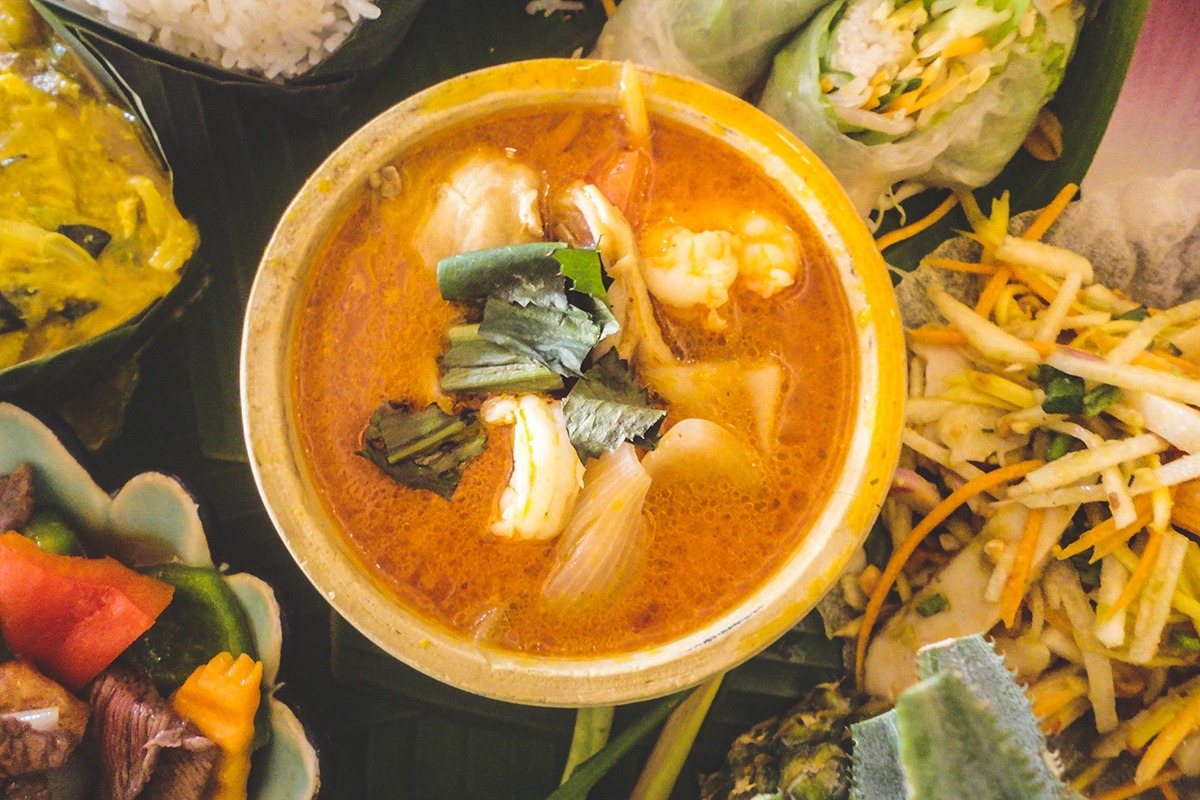
Samlor Machu
Samlor machu refers broadly to a group of sour soups that vary by region and ingredients. You might encounter Samlor machu youn, made with tomato, tamarind, and pineapple, or Samlor machu kroeung, which incorporates lemongrass paste and beef. The flavor is always vibrant, featuring tangy and aromatic notes balanced with sweetness from tomatoes or sugar palm. These soups are staples of family meals and are often cooked in big pots to serve groups. It’s a wonderful example of Cambodian food built around sharing.

Noum Kong
One of the most recognizable Khmer street food treats, Noum Kong are chewy, sticky rice flour donuts with a sweet glaze of palm sugar and sesame seeds. Shaped like mini wheels and fried to a golden crisp, they’re commonly sold from roadside carts near busy markets. Grab a couple for a quick snack or a simple dessert. They’re especially delicious when served warm and fresh from the fryer.

Kampot Pepper Crab
This signature dish hails from the neighboring towns of Kampot and Kap, where the waters supply fresh blue crab and the nearby hills grow Cambodia’s legendary pepper. Stir-fried with shallots, garlic, and green peppercorns still on the stem, it’s sweet, spicy, and just the right amount of messy. This is coastal Khmer cuisine at its finest. Pair it with steamed jasmine rice and a cold Angkor Beer and enjoy while watching the ocean.
Culinary Delights Across Cambodia
Great food can be found everywhere in Cambodia, from bustling city restaurants to humble roadside grills. Each region also has its own unique culinary personality, shaped by local ingredients, traditions, and cultural influences. Here’s where to go and what to eat when planning your Khmer food adventure across the country.
Siem Reap: A Blend of Tradition and Innovation
Siem Reap might be known for temples, but its food scene is also legendary. As a hub for both backpackers and boutique travelers, the city has cultivated an impressive dining landscape that includes fine dining, fusion, and plant-based Khmer food. Whether you’re in a quiet garden cafe or a high-end tasting room, Siem Reap serves up some of the most exciting plates in the country at these top-notch restaurants:
- Cuisine Wat Damnak: Chef Joannès Rivière’s celebrated restaurant fuses French culinary technique with Cambodian ingredients. Sourcing ingredients from local farms across the country, the ever-changing menu highlights seasonal produce, freshwater fish, and regional specialties for a truly unique dining experience.
- Blanc Leaf Restaurant: A bright, modern space serving a mix of Asian and Western cuisine, along with standout Khmer dishes and fresh vegetarian options. The menu features carefully selected and locally sourced produce as well. Even better? Visa cardholders enjoy a 10% discount, making it both delicious and practical.
- Malis: Located just minutes from Angkor Wat, Malis celebrates Cambodian cuisine with a menu rooted in tradition and inspired by the flavors of the Angkor era. Set on a tranquil garden terrace surrounded by greenery, it’s a serene spot to experience Cambodia’s rich culinary heritage.
- Dermkiri Restaurant: Offers a relaxed but upscale atmosphere in a traditional wooden Khmer house with a solid menu of Khmer favorites. Visa users receive an exclusive 15% off food and beverages here too, making it a great value for a refined night out.

Phnom Penh: The Heartbeat of Khmer Flavors
The capital’s food culture mirrors the city itself: dynamic, busy, and brimming with flavor. Here, old markets meet modern kitchens, and Khmer cuisine is celebrated from the street to the skyline. You’ll find vendors grilling skewers beside colonial-era cafes and rooftop bars offering elevated takes on classic dishes. Phnom Penh is a place where tradition and innovation share the same table, particularly at these spots:
- Kravanh: A refined approach to classic Cambodian cuisine, using sustainably sourced ingredients from across the country. Founder Toan Ek Sophie partners directly with small-scale producers and farmers to create a menu that honors traditional Khmer recipes.
- Sombok: One of Phnom Penh’s most polished dining experiences, Sombok focuses on seasonal produce. The highlight here is the stunning visual presentation of the food. Visa discounts apply as well, making luxury dining more accessible.
- Villa 5: Set in a two-story villa, this restaurant offers a sophisticated dining experience in Phnom Penh. The menu features contemporary cuisine with Khmer influences, available a la carte or as part of a curated set menu.
- Sora Skybar: Perched on the 37th floor, Sora is Phnom Penh’s highest rooftop bar, offering sweeping views of the city skyline. The bar serves a menu of tapas-style bites and over 20 craft cocktails infused with local ingredients, alongside an extensive whisky library.
- Le Phnom 1929: Blending French bistro elegance with Cambodian warmth, this spot is ideal for travelers who enjoy a bit of both worlds. Dishes like confit duck with Khmer-style beef tartare pair beautifully with the wine list. Visa cardholders can enjoy 50% off the set menu.

Kampot & Kep: Coastal Culinary Gems
Down south, life slows down, and so does the dining. Kampot and Kep offer a quieter, more intimate food scene with an emphasis on fresh ingredients and local flavors. Meals are often enjoyed at a relaxed pace, with river or ocean views as your backdrop. From seafood caught the same day to tropical fruits grown just up the road, the region’s ingredients are as much a part of the experience as the dishes themselves.
- Rikitikitavi Restaurant: This riverside favorite in Kampot offers a relaxed setting with views of the river and nearby mountains. The menu features a mix of Cambodian and international dishes, along with fresh seafood sourced daily from the local fishing fleet.
- Kep Crab Market: This isn’t just a place to buy seafood but an attraction in its own right. Wander through stalls selling grilled crab, seafood fried rice, or octopus on skewers. Then enjoy your meal at a table overlooking the ocean.
FIND MORE VISA OFFERS AND DINING PERKS
Seamless Payment with Visa
No matter where you go in Cambodia, using Visa makes every transaction easier. From bustling Phnom Penh to quiet Kep, you can pay securely, contactlessly, and without worrying about carrying large amounts of cash. Whether you’re booking a table at upscale restaurants in Cambodia or grabbing Khmer street food from a local vendor, Visa helps simplify the experience. Plus, don’t forget that select Cambodia restaurants offer exclusive restaurant deals with Visa, including Blanc Leaf, Dermkiri, Sombok, and Le Phnom 1929. So not only do you dine well, you also save smart. Just tap to pay, and enjoy your meal!
Introducing the Bakong Tourist App
For a smoother, smarter way to travel and dine in Cambodia, the Bakong Tourist App is your new best friend. Developed in collaboration with the National Bank of Cambodia, this all-in-one mobile app takes the hassle out of managing your money on the go. Whether you’re dining or shopping, the Bakong Tourist App streamlines every transaction. Key features include:
- Top up your wallet using your Visa card for easy access to funds anytime.
- Make secure QR payments at over 5 million retail merchants across Cambodia, including restaurants, markets, shops, and more.
- Track your spending and manage transactions effortlessly, all in one place.
Whether you’re embarking on a culinary adventure or exploring Cambodia’s peaceful island escapes, the Bakong Tourist App makes your journey cashless and convenient, while your Visa card makes it secure. You can download the app from Google Play Store or the Apple App Store to begin enjoying your cashless adventure.
Want to unlock even more travel perks and exclusive dining offers? Visit Visa Offers and Perks to learn more. Happy travels!



